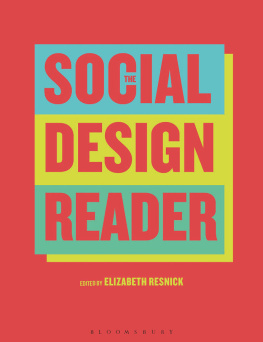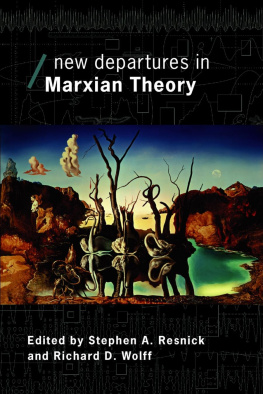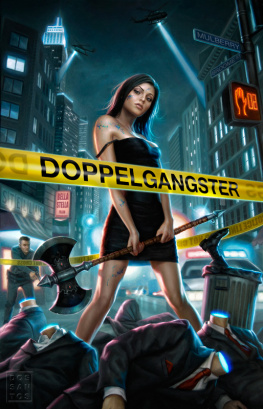Elizabeth Resnick - The Social Design Reader
Here you can read online Elizabeth Resnick - The Social Design Reader full text of the book (entire story) in english for free. Download pdf and epub, get meaning, cover and reviews about this ebook. year: 2019, publisher: Bloomsbury Publishing, genre: Politics. Description of the work, (preface) as well as reviews are available. Best literature library LitArk.com created for fans of good reading and offers a wide selection of genres:
Romance novel
Science fiction
Adventure
Detective
Science
History
Home and family
Prose
Art
Politics
Computer
Non-fiction
Religion
Business
Children
Humor
Choose a favorite category and find really read worthwhile books. Enjoy immersion in the world of imagination, feel the emotions of the characters or learn something new for yourself, make an fascinating discovery.
- Book:The Social Design Reader
- Author:
- Publisher:Bloomsbury Publishing
- Genre:
- Year:2019
- Rating:3 / 5
- Favourites:Add to favourites
- Your mark:
- 60
- 1
- 2
- 3
- 4
- 5
The Social Design Reader: summary, description and annotation
We offer to read an annotation, description, summary or preface (depends on what the author of the book "The Social Design Reader" wrote himself). If you haven't found the necessary information about the book — write in the comments, we will try to find it.
The Social Design Reader — read online for free the complete book (whole text) full work
Below is the text of the book, divided by pages. System saving the place of the last page read, allows you to conveniently read the book "The Social Design Reader" online for free, without having to search again every time where you left off. Put a bookmark, and you can go to the page where you finished reading at any time.
Font size:
Interval:
Bookmark:
THE SOCIAL DESIGN READER
This book is dedicated to the memory of my colleague, mentor, and friend
Albert J. Gowan (19342017)
Professor Emeritus, Massachusetts College of Art and Design, Boston
Author of Victor Papanek: Path of a Design Prophet
THE SOCIAL DESIGN READER
Edited by
Elizabeth Resnick

CONTENTS
Elizabeth Resnick
Cameron Tonkinwise
Victor Margolin
Alison J. Clarke
Elizabeth Resnick
Ken Garland
Ken Garland
Victor Papanek
Clive Dilnot
Nigel Cross
Victor Papanek
John Heskett
Richard Buchanan
Katherine McCoy
Nigel Whiteley
Andrew Howard
Jan van Toorn
Anthony Dunne
Elizabeth Resnick
Victor Margolin and Sylvia Margolin
Jorge Frascara
William McDonough and Michael Braungart
Kate Fletcher
Ann Thorpe
Daniela Sangiorgi
Lucy Kimbell
Lucy Kimbell
Erling Bjgvinsson, Pelle Ehn, and Per-Anders Hillgren
Guy Julier
Elizabeth (Dori) Tunstall
Cinnamon Janzer and Lauren Weinstein
Pedro J. S. Vieira de Oliveira and Luiza Prado de O. Martins
Luiza Prado de O. Martins
Elizabeth B.-N. Sanders
Ezio Manzini
Ahmed Ansari
Terry Irwin
This collection of seminal texts simply could not have been possible without the very generous support of all the contributors to this effort: Ahmed Ansari, Erling Bjrgvinsson, Gui Bonsiepe, Scott Boylston, Max Bruinsma, Michael Braungart, Richard Buchanan, Sharon Burdett, Valerie Casey, Jonanthan Chapman, Alison J. Clarke, Nigel Cross, Sheila Levrant de Bretteville, Decolonising Design, Clive Dilnot, Carl DiSalvo, Kees Dorst, Anthony Dunne, Pelle Ehn, Joost Elffers, David Evans, Terence Fenn, Kate Fletcher, Jorge Frascara, Alastair Fuad-Luke, Nick Gant, Ken Garland, John Heskett, Per-Anders Hillgren, Jason Hobbs, Stefan Holmlid, Andrew Howard, Gordon Hush, Terry Irwin, Tim Jackson, Cinnamon Janzer, Guy Julier, Lucy Kimbell, Ilpo Koskinen, Diana Krabbendam, Klaus Krippendorff, Kalle Lasn, Ezio Manzini, Victor Margolin, Katherine McCoy, William McDonough, Ivica Mitrovic, Chantal Mouffe, David Oswald, Rev. Nicolette Papanek/Victor Papanek, Luiza Prado de O. Martins, Elizabeth B.-N. Sanders, Daniela Sangiorgi, Michiel Schwarz, Ann Thorpe, Cameron Tonkinwise, Elizabeth (Dori) Tunstall, Jan van Toorn, Pedro Vieira de Oliveira, Lauren Weinstein, and Nigel Whiteley.
There are a few individuals who deserve special thanks for their encouragement and advice during the book project: Lisa Abendroth, Fatima Cassim, Audra Buck Coleman, Annelys de Vet, Ariel Guersenzvaig, Terry Irwin, Jackie Malcolm, Massimo Santanicchia, and Victor Margolin for his patience with my questions and frequent requests for advice.
I am indebted to my editor, Rebecca Barden, for giving me this unique opportunity to create The Social Design Reader . I wish to thank her editorial assistant, Claire Constable for keeping me on track and for all the small things she helped me with during the course of this project.
And, I am very grateful and thankful to my husband, Victor Cockburn, and my adult children, Alex and Elana, who all endured my distraction and frequent spells of anxiety with encouragement and grace.
FIGURES
TABLES
The Social Design Reader is an anthology of key writings written over the past fifty-five years by leading proponents, researchers, and practitioners shaping the emergence of socially responsible design as a concept, as a nascent field of study, and as a developing discipline within professional design practice.
During the past thirty-five years, there has been a tsunami of books published on the subject of designexpounding on its critical nature, its history, its technology, and its continuously evolving culture of professional practice and significant practitioners. Art and design libraries (typically housed in colleges and universities) have archived many of the important international design magazines and academic journals from the early twentieth century to the present day. With the rise of the internet and the demand for easily accessible research materials to build a history of design culture and activity, there has been a vigorous movement toward anthologizing historically significant texts and articles previously published in design magazines and academic journals that are simply not accessible to the public, as many such publications are either out-of-print or housed in private libraries or collections that are very expensive to access.
An anthology is above all, a collaborative work. My aim with this compilation is to bring together a group of authentic voicestheorists, scholars, writers, and designerswho are building a canon of informed literature that documents the genesis and rapid development within this field of study. In concert, these texts build upon the notion that social design is design with a conscience , and, as such, can help the reader understand how design can be employed as a catalyst for social change. Editing an anthology of this nature can be quite a daunting task, especially for someone without experience in this genre and format.
There are many restrictions when framing a compilation of this kind: contracted word count; the stringency of academic permission fee budgets; the availability of key texts; and the ensuing economic and physical challenge to gain permission to republish them. Another contributing factor to the framing of this anthology is its bias for language preferencethe All pivotal criteria that contributed to the selection of what texts to publish.
The crucial advantage to this type of anthology is its ability to feature texts emphasizing the theoretical and discursive dialogue threads from multiple perspectives current within mainstream academic and professional discourse, and those from the margins of the status quo. The texts were reproduced as they had been first publishedwritten in either British English or American English. A unique aspect that emerges from such a diversity of voices is the different and distinctive writing styles that should be embraced by the reader.
Structure of the Reader
The Social Design Reader is divided into three sections:
: Making a Stand: A New Social Agenda for Design includes the introduction to the term social design and papers that explore its historical underpinnings to build a foundation to support the expanding dialogue and embody the social design movement.
: Creating the Future: Defining the Socially Responsible Designer 196499 feature papers that document the emergence of social design as a concept, as a nascent field of study, and as a rapidly developing professional discipline.
: A Sea Change: The Paradigm Shift from Objects to Systems 200020 feature papers that acknowledge design as a firmly established professional discipline. As such, there is an increased need for both quantitative and qualitative research that utilizes strategic and critical thinking as designers are now being challenged to tackle complex social problems during the first two decades of the twenty-first century.
Contextualizing section introductions are provided to assist readers in understanding the nature of the material discussed along with summary messages that articulate how each text fits within the larger milieu of social design theory, methods, and practice.
Key Features
The Social Design Reader brings together previously published seminal papers, essays, articles, and excerpts with a laser focus on the social nature of design to provide the reader with a solid overview of the trajectory and key advancements toward a more human-centered profession.
Next pageFont size:
Interval:
Bookmark:
Similar books «The Social Design Reader»
Look at similar books to The Social Design Reader. We have selected literature similar in name and meaning in the hope of providing readers with more options to find new, interesting, not yet read works.
Discussion, reviews of the book The Social Design Reader and just readers' own opinions. Leave your comments, write what you think about the work, its meaning or the main characters. Specify what exactly you liked and what you didn't like, and why you think so.













